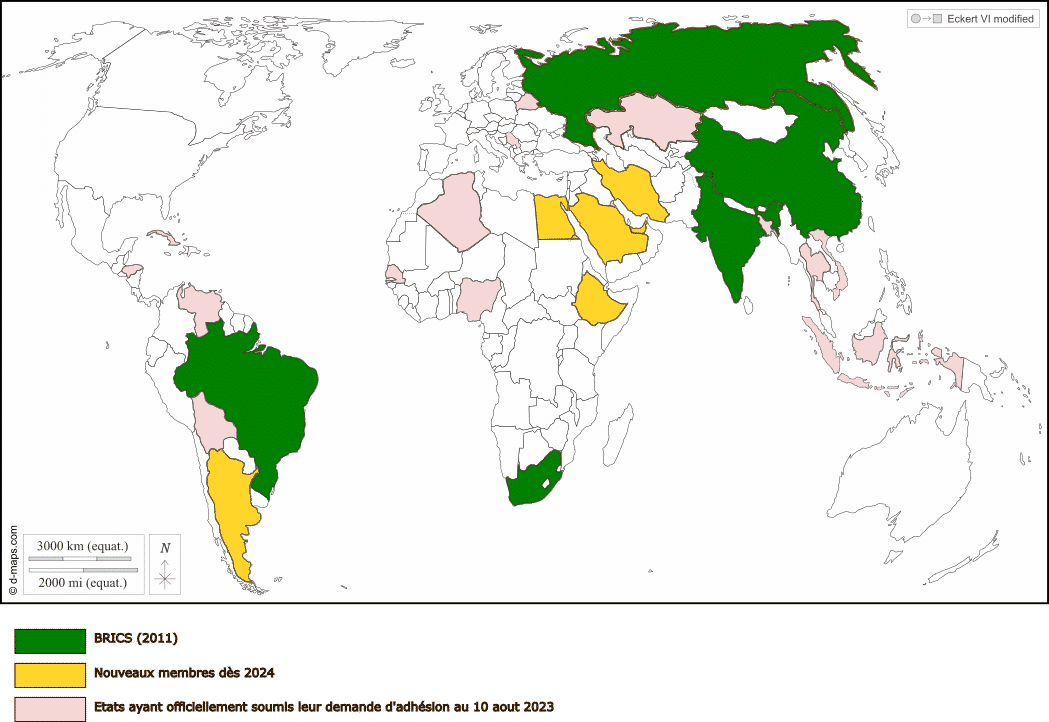At their recent summit in Johannesburg, the BRICS set out a roadmap for a new phase of development, with six new members joining the bloc. This should increase the weight of this counter-club to the G7 and pave the way for major geostrategic changes, notably in the global financial system and the de-dollarization of trade.
From August 22 to 24, the members of the BRICS met for a summit in Johannesburg. On this occasion, the member countries – Brazil, Russia, India, China and South Africa – drew up a roadmap. This outlines a new phase in the development of the BRICS, emphasizing inclusive multilateralism, mutually accelerated growth and sustainable development.
Above all, South African President Cyril Ramaphosa declared on August 24 that six new countries would be welcomed as of January. Iran, Argentina, Egypt, Ethiopia, Saudi Arabia and the United Arab Emirates will join the group of emerging nations seeking to increase their global influence.
“Membership will take effect from January 1, 2024,” the South African president told a joint press conference of the leaders of the five nations that currently make up the bloc. “With this summit, the BRICS begin a new chapter,” he said.
With its new members, the BRICS now carry more weight: they now account for 29% of world GDP, 46% of the population, 43% of oil production and 25% of product exports. This association of countries, which for the first time includes members of the Organization of the Petroleum Exporting Countries (OPEC), is setting itself up as a counter-club to the G7, a kind of alternative to Western power.
An alliance of emerging countries
The BRICS group originally comprised large middle-income countries with fast-growing economies.
The acronym BRICS was first coined in 2001 by British economist Jim O’Neill, in a report by investment bank Goldman Sachs entitled Building Better Global Economic BRICs (the final “S” being plural and not referring to South Africa). Among other things, he predicted that they could become the world’s leading economies by 2050.
In 2006, Brazil, Russia, India and China officially joined forces to form the BRIC group. South Africa joined in 2010.
Applying the principle of expansion
The question of the group’s expansion was the priority of this 15th summit. A heterogeneous alliance of geographically distant countries and unevenly growing economies, the BRICS had to agree on the strategic choice of new entrants.
At the summit, South Africa’s capital Pretoria announced that all member countries had agreed on the principle of expansion. “We have adopted a document that defines the guidelines, principles and review processes for countries wishing to become members of the Brics,” said the South African Foreign Minister, underlining a “positive” step forward.
China, which accounts for around 70% of the group’s GDP, clearly supported this expansion of the BRICS. However, India, another major economic player in the group but wary of its rival China’s ambitions in the region, expressed reservations. Indian Prime Minister Narendra Modi stressed the need for “consensus” on modalities, whereas the BRICS decision-making process requires unanimity. On the other hand, Brazil expressed concern that expansion would dilute its influence both globally and within the bloc.
At the summit, the BRICS reaffirmed their “non-aligned” position, a point all the more crucial at a time when divisions were exacerbated by the conflict in Ukraine.
The door remains wide open: dozens more countries could join the bloc in the future. This enlargement represents a major step forward not only in the development of the BRICS, but also in the transformation of the world. Against this backdrop, the USA has declared that it does not see the BRICS as future “geopolitical rivals”, and has expressed its willingness to maintain “solid relations” with Brazil, India and South Africa.
Geostrategic objective
The decision to integrate these new countries is a geostrategic objective. Saudi Arabia and the United Arab Emirates play a significant role as powerful financial centers and commercial hubs, strategically positioned at the crossroads of Africa, Asia and Europe. The presence of BRICS in the Persian Gulf would considerably strengthen the region’s passage in terms of security. Egypt’s participation would also help alleviate concerns about the security of the Suez Canal, a major source of worry for supply chain managers worldwide.
Read also>FASHION BRANDS ARE PROVIDING ASSISTANCE TO THE VICTIMS OF THE HAMAS-ISRAEL CONFLICT
Featured photo : ©Press
































